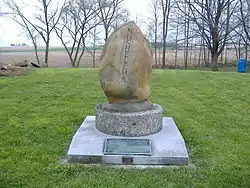Nonhelema
Nonhelema Hokolesqua[1] (c. 1718–1786) Born in 1718 into the Chalakatha (Chilliothe) division of the Shawnee nation and spent her early youth in Pennsylvania. Her brother Cornstalk, and her metis mother Katee accompanied her father Okowellos to the Alabama country in 1725. Their family returned to Pennsylvania within five years. In 1734 she married her first husband, a Chalakatha chief. By 1750 Nonhelema was a Shawnee chieftess[1] during the 18th century and the sister of Cornstalk, with whom she migrated to Ohio and founded neighboring villages.
Nonhelema | |
|---|---|
 Nonhelema monument | |
| Shawnee leader | |
| Personal details | |
| Born | ca. 1720 |
| Died | December 1786 |
| Spouse(s) | A Shawnee man, Chief Moluntha |
| Relations | Sister of Cornstalk |
| Children | Son, "Captain Butler" (or Tamanatha) |
| Military service | |
| Nickname(s) | "The Grenadier" or "The Grenadier Squaw" |
| Battles/wars | Bushy Run |

Nonhelema, known as a warrior, stood nearly six feet, six inches (198 cm).[2] Some called her "The Grenadier" or "The Grenadier Squaw", due to the large height of 18th-century grenadiers.
Nonhelema had three husbands. The first was a Shawnee man.[3] The third was Shawnee Chief Moluntha.[2] She had a son, Thomas McKee, through her relationship with Indian agent Colonel Alexander McKee and another son, Captain Butler/Tamanatha, through her relationship with Colonel Richard Butler.
Nonhelema was present at the Battle of Bushy Run in 1763. She and her brother, Cornstalk, supported neutrality when their land became the Western theater of the American Revolutionary War. In Summer 1777, Nonhelema warned Americans that parts of the Shawnee nation had traveled to Fort Detroit to join the British.[4] Following Cornstalk's 1777 murder at Fort Randolph, Nonhelema continued to support the Americans, warning both Fort Randolph and Fort Donnally of impending attacks. She dressed Philip Hammond and John Pryor as natives so they could go the 160 miles to Fort Donnally to give warning. In retribution, her herds of cattle were destroyed. Nonhelema led her followers to the Coshocton area, near Lenape Chief White Eyes.[4] In 1780, Nonhelema served as a guide and translator for Augustin de La Balme in his campaign to the Illinois country.[2]
In 1785, Nonhelema petitioned Congress for a 1,000-acre grant in Ohio, as compensation for her services during the American Revolutionary War. Congress instead granted her a pension of daily rations, and an annual allotment of blankets and clothing.[2]
Nonhelema and Moluntha were captured by General Benjamin Logan in 1786. Moluntha was killed by an American soldier, and Nonhelema was detained at Fort Pitt. While there, she helped compile a dictionary of Shawnee words.[2] She was later released, but died in December 1786.[2]
Fictional depictions
Nonhelema is the subject of Warrior Woman, a 2003 novel authored by James Alexander Thom and Dark Rain Thom.[5]
She is portrayed by Karina Lombard in the November 2016 episode "Stranded" of the NBC TV series Timeless.[6]
References
- McEuen, Melissa A. (2015). Kentucky Women Their Lives and Times. Athens, Georgia 30602: The University of Georgia Press. pp. 12–13. ISBN 978-0-8203-4453-9.CS1 maint: location (link)
- Cook, Bernard A. (ed); Gundersen, Joan (2006). Women and war: a historical encyclopedia from antiquity to the present. ABC-CLIO. p. 434. ISBN 9781851097708. Retrieved 29 Nov 2011.CS1 maint: extra text: authors list (link)
- Winkler, John F (2011). Wabash 1791. St. Clair's defeat. Oxford, UK: Osprey Publishing. p. 19. ISBN 978-1-84908-676-9.
- Nash, Gary B. (2006). The Unknown American Revolution: The Unruly Birth of Democracy and the Struggle to Create America. London: Penguin Books. p. 255. ISBN 978-0-14-303720-0. Retrieved 28 Nov 2011.
- "Fiction Review - Warrior Woman: The Exceptional Life Story of Nonhelema, Shawnee Indian Woman Chief". Publishers Weekly. Retrieved 27 November 2011.
- Foster, Ann (November 22, 2016). "With death on the line, Timeless forges new ground". ScreenerTV.com. Retrieved November 29, 2016.